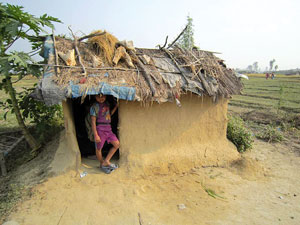 |
Less than two weeks after submitting their demand, the Maoists launched the 'people's war' on 15 February 1996, attacking police stations.
The man who drafted that 40-point demand is now the prime minister of the country, and it is supreme historical irony that he was handed the same demands by landless people aligned to a faction that has split off from his party.
The 2006 Comprehensive Peace Agreement (CPA) and subsequent political agreements committed the Maoists to return the seized land to its owners, and a government commitment to land reform.
However, in a recent report The Carter Centre has found that these commitments have only been partially fulfilled. While most of the land seized in the hills, mountains, and parts of the eastern and central plains have been returned, in the Mid and Far-Western Tarai where the largest number of seizures had reportedly occurred, they have either not been returned or given back conditionally.
Bardiya was where large tracts of private farms were captured by the Maoists, especially around the Rajapur area in the western parts of the district. Officials figures show 604 hectares were captured in 24 VDCs, but local politicians and civil society believe the area could be up to 1,422 hectares.
In Bara district, around 5,000 people are living in seized land while another thousand houses have been built illegally in occupied plots in Chitwan. Similarly, in Dang an estimated 1,829 hectares of land belonging to Nepal Sanskrit University, Mahendra Campus, Ratannath Temple and Sowrgadwari Temple have been occupied by the landless, and squatters.
The report cites complex dynamics underlying the seizures, and advises the government against any forced evictions that could lead to violent confrontation between the security forces and the illegal occupants.
"The political parties should stop using vulnerable populations for their political ends," The Carter Centre advocates, adding that a credible committee be set up to determine the principle and procedures governing land return.
Besides calling on the Maoists to return all the remaining seized properties under their control, the report suggests the need for a comprehensive land policy and reform as a long-term solution to the issue. "Land commitments remain important in the peace process and if left unaddressed, they may cause further challenges in the future," Carter Centre's Sarah Levit-Shore told Nepali Times.
In November last year, following the seven-point agreement, the Maoists had expressed a time bound commitment to return the seized land and properties, but the hardliners in the party prevented the return demanding alternatives for tillers, landless, and squatters.
But after the split in the party, the case has become more complicated with the Mohan Baidya group radicalising the issue to garner its support base among the landless. In some districts, landowners were given a share of the harvest, but the Maoists or the groups closely protected by them continue to occupy the land and pocket millions from it.
The owners say authorities have failed to enforce land return and did not want to involve district administration or the police in the matter anymore. There have been cases where the owners have paid hefty sums to get their land back.
Hundreds of hectares of land are still being occupied in Kailali, Kanchanpur, Chitwan, Sankhuwasabha, Arghakhanchi, Banke and Dhanusha. The government established Local Peace Committees (LPCs) to facilitate the settling of the land disputes, but the committee itself has become a political battleground. As a result, various factions of the Maoists including the ones led by Matrika Yadav, Mohan Baidya and ethnic groups like Limbuwan continue to illegally occupy and harvest public and private land.
Full text of The Carter Centre report:
www.cartercenter.org/resources/pdfs/peace/democracy/nepal-land-062012-eng.pdf
Read also:
Anger management, ANURAG ACHARYA
Attacks on private schools are a manifestation of the class divide in education


